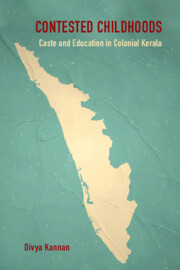1 - Cast(e)ing Schools
Published online by Cambridge University Press: 28 November 2024
Summary
Upon their arrival on the southwestern coast of India in the early decades of the nineteenth century, British Protestant missionaries of the London Missionary Society (LMS) and the Church Missionary Society (CMS) found themselves in a complex and challenging position. Fed on the Orientalist writings of early European travellers and traders and armed with biblical scriptures, the missionaries had undertaken long sea voyages to introduce a new religion to the ‘heathen’ populations in the strange, tropical world. Their mandate was to conduct direct biblical preaching, but this was impossible without adequate language training, and in the initial years, they relied heavily on local scholars and translators. Another avenue for winning converts lay before this earliest group of male missionaries, one that seemed to hold enormous potential as their itinerant tours continued: schools. In the decades to follow, the formal school site enabled the emergence of a plurality of meanings as different interest groups cooperated and conflicted and embedded schooling within evolving local norms and ideals of childhood. Colonial Kerala was no exception.
In mounting a relentless critique of extant pedagogical methods pursued in the indigenous schools of the region, British colonial administrative and missionary agendas coalesced to produce the formal, modern school with its fixed physical contours and ‘textbook culture’ as integral to the ideology of civilizing missions. British missionary men and women contended with the indigenous school network commandeered by individual teachers whose primary responsibility lay in imparting basic literacy to young boys, especially from the so-called upper castes and religious groups in Travancore and Cochin. By the mid-nineteenth century, a new index of societal progress thus started taking shape alongside the gradually acceptable notion that children's physical, intellectual, and emotional development must occur under adult supervision in segregated spaces of literacy and training. The LMS and the CMS found their most formidable adversaries in caste and its numerous adherents and began establishing primary mission schools and translating the Bible as a means of imparting ‘useful knowledge’.
From the 1820s onwards, these British missionaries, located in parts of Travancore and Cochin, combined itinerant preaching with educational work.
- Type
- Chapter
- Information
- Contested ChildhoodsCaste and Education in Colonial Kerala, pp. 35 - 78Publisher: Cambridge University PressPrint publication year: 2025

